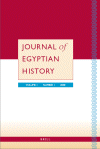Journal of Egyptian History (1) 2008

(all articles are available free as pdf files now)
Journal of Egyptian History
ISSN 1874-1657
Volume 1, Number 1, 2008
Preface
Journal of Egyptian History: Preface
pp. 1-2(2)
Author: Schneider, Thomas
Articles
Regarding the Eisagogeus (εισαγωευς) At Ptolemaic Law Courts
pp. 3-19(17)
Author: Allam, Schafik
Zur Reflexion Ptolemäischer Geschichte In Den ägyptischen Tempeln Aus Der Zeit Ptolemaios IX. Philometor II./Soter II. Und Ptolemaios X. Alexander I. (116-80 V. CHR.) Teil 1: Die Bau- Und Dekorationstätigkeit
pp. 21-77(57)
Authors: Caßor-Pfeiffer, Silke
Profit or Exploitation?
The Production of Private Ramesside Tombs Within the West Theban Funerary Economy
pp. 79-115(37)
Author: Cooney, Kathlyn M.
Function and Significance of the Ebers Calendar's Lone Feast-Hieroglyph (Gardiner Sign-List W3)
pp. 117-138(22)
Author: Depuydt, Leo
Some Remarks on the Foreign Policy of Psammetichus II in the Levant (595-589 B.C.)
pp. 139-157(19)
Author: Kahn, Dan'el
King Seneferka in the King-lists and His Position in the Early Dynastic Period
pp. 159-173(15)
Author: Ryholt, Kim
Method and Theory
Geschichtswissenschaft Am Beginn Des 21. Jahrhunderts: Themen, Methoden Und Tendenzen in Internationaler Perspektive
pp. 175-200(26)
Author: Raphael, Lutz
Notes for Contributors
pp. 201-205(5)








